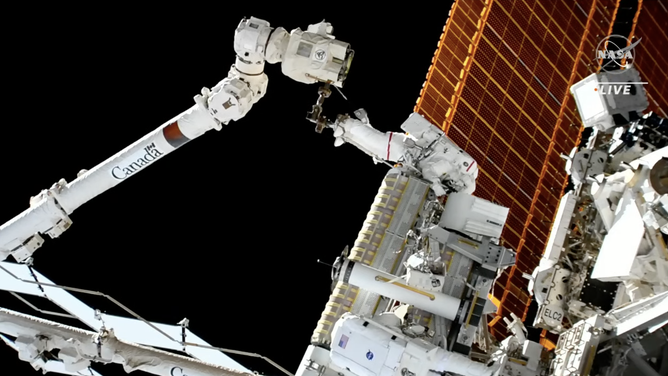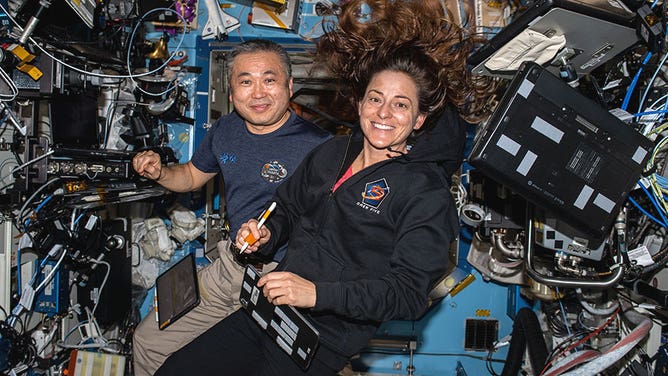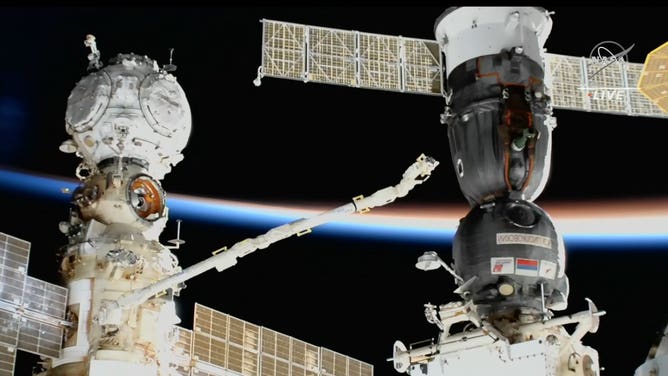First spacewalk of the year continues flurry of space station activities – Fox Weather
Two astronauts will complete the first spacewalk of the year continuing a rush of activity on the International Space Station as the orbiting laboratory prepares for another busy year of research in low-Earth orbit.
NASA astronaut Nicole Mann and Japan Aerospace Exploration Agency (JAXA) astronaut Koichi Wakata will begin their 6.5-hour spacewalk on Friday around 8 a.m. after exiting the ISS airlock.
Wakata will wear the spacesuit with red stripes, and Mann’s spacesuit will be stripe-less.
This will mark the first spacewalk for both astronauts and allow all the Crew-5 astronauts to have completed at least one spacewalk during their mission. The Crew-5 mission is Mann’s first spaceflight. Wakata recently marked his 400th cumulative day in space throughout his career.
Mann and Wakata’s tasks outside the ISS will be to install a frame, known as struts, to support the next pair of international Roll-Out Solar Arrays known as iROSAs.
There are four iROSAs currently installed outside the International Space Station installed over a handful of spacewalks as part of an effort to upgrade the station’s power grid. The solar arrays arrive in space rolled up like carpets and unfurl in space.
“They’re supplying about nine kilowatts of power, which is going towards a lot of payloads and science,” NASA’s Spacewalk Flight Director Chloe Mehring said of the four iROSAs.
The astronauts will also tighten some bolts and cables. If there is time, they could complete some “get ahead tasks” working ahead to help speed up the next iROSA installation.

NASA’s ISS Program operations integration manager Dina Contella estimated the next set of solar arrays from Boeing and Redwire Space would launch sometime in June on SpaceX’s 28th resupply mission to the space station.
NASA management has been pleased with the new roll-out of solar arrays. The space agency also plans to use the arrays on Gateway, a small orbiting outpost around the moon where astronauts will stop before heading down to the lunar surface.
“When you see the arrays unfurl, and they seem to do so perfectly and then provide power right away, it’s really impressive,” Contella said. “This is proving this is a good technology. They’re lightweight and flexible, easy to launch. And I do think this is a really good methodology, and we are planning to use it in the future.”
NASA lead spacewalk Officer Keith Johnson said the innovative iROSAs are a step forward in power generation technology.
“It’s always the right direction to be able to update and accommodate higher power capacity, higher storage, and for all the use that we want to get out of the station,” Johnson said.
Activity on the International Space Station is always ongoing, and the astronauts live by a very detailed schedule. Their days are packed with science research, outreach events talking to people back on Earth, ISS maintenance, working out in the low-gravity gym, personal time and sleep.

Since November, astronauts have completed three spacewalks, and Northrop Grumman and SpaceX cargo supply vehicles have either come or gone from the space station.
“It’s been really busy,” Contella said. “We’ve had a lot happening, I’d say. Multiple vehicles coming and going and spacewalks.”
Additionally, the crew has made adjustments due to the Russian Soyuz spacecraft leaking coolant.
The spacecraft was how Roscosmos cosmonauts Sergey Prokopyev and Dmitri Petelin and NASA Astronaut Frank Rubio arrived at the ISS in September and would have been their ride home before it began leaking coolant. Engineers believe the leak was caused by a space debris strike to the spacecraft.
Now Russia will send up another Soyuz spacecraft in mid-February to bring the crew back to Earth.

Contella said after the new Soyuz arrives, the crew will spend “several more months” in space before coming home, possibly in September. The problem Soyuz spacecraft will autonomously return to Earth after the new one arrives.
Until the new Soyuz arrives, the astronauts moved Rubio’s seat liner to the SpaceX Crew Dragon in case of an emergency evacuation. The old Soyuz will remain the emergency evacuation plan for Prokopyev and Petelin.
NASA and SpaceX are planning to launch the Crew-6 astronaut mission to the ISS in late February, and the Crew-5 astronauts would undock and return home a few days after the Crew-6 mission’s arrival.
STELLAR SNACK: HOW A BLACK HOLE EATS A DOOMED STAR FOR BREAKFAST
There are also two re-supply missions planned for February, Russia’s Progress supply vehicle and SpaceX’s Cargo Dragon on its 27th re-supply mission for NASA.
Northrop Grumman’s Cygnus cargo spacecraft that arrived in November will undock from the ISS sometime in March.
In April, Boeing is scheduled to launch its first astronauts to the ISS on the CST-100 Starliner. The crewed flight test will be the final step to certify Boeing’s capsule to fly astronauts as part of NASA’s Commercial Crew Program like SpaceX has been doing since 2020.







